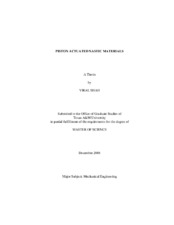| dc.description.abstract | This study investigated nastic materials applied to twisting a rigid beam. Nastic
materials contain small, simple machines in a compliant matrix. Here a generic beam
must twist by ± 4 degrees; the ± 4 degrees twist is an optimum value to change the angle
of attack on a helicopter’s rotor blade. Small piston actuators distributed through the
beam’s outer core provide the internal work needed. By actuating the piston elements in
their axial direction, which is transverse to the beam’s central axis, the beam twists as
desired. This study’s objective is to gain insight into the geometry, the material property
combinations, and the boundary conditions that produce nastic materials and structures
that twist. An important performance metric is the work density, which is the product of
blocked stress and free strain. Blocked stress is the maximum actuation stress in a single
stroke that produces maximum work output and free strain is the maximum actuation
strain that produces the maximum work output.
Optimum work density was found for the piston actuators. As it is difficult to model
distributed piston actuators across the beam’s outer core, piston actuator’s effective
properties are calculated using finite element models and homogenized in the beam’s
outer core.
As the goal is to twist a beam, an important parameter in comparing the active beam to a passive beam is torsional stiffness. Torsional stiffness is torque per unit deflection.
The active beam’s torsional stiffness is 13.705 MN-m/rad without twist in the initial
state, which is 3.5 times stiffer than the passive beam, and 13.341 MN-m/rad at the
twisted state, which shows that the beam loses 2.6% of its stiffness during twist. The
passive beam’s density is 1000.01 kg/m3 and the active beam’s density is 1399.42 kg/m3,
which shows that active structures have a weight penalty that must be less than
achieving the motion by traditional systems. | en |


